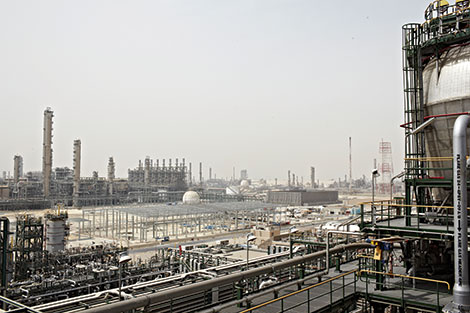Our Approach and Performance
A strong emphasis on resource and energy efficiency in every aspect of corporate strategy, culture, and operations.
We continue to work towards our ambitious, company-wide, resource-and energy-efficiency sustainability goals: reducing greenhouse-gas, energy, and water intensities by 25 percent, and material-loss intensity by 50 percent, from 2010 levels by 2025.
We have achieved positive results to date by driving a sustainability culture, training employees, and applying operational excellence. We commit to innovation and efficiency improvement, and provide the structure and guidance to achieve it. To do so, SABIC and its manufacturing affiliates rigorously monitor and evaluate performance, with the Corporate Sustainability department reporting the results and striving for continuous improvement. Our Manufacturing corporate function works closely with Technology and Innovation, and Finance on sustainability progress. The overall direction is reviewed twice a year and updated by the CEO and the Sustainability Council.
Through a combination of culture, experience, and commitment, SABIC is poised for long-term success as a sustainable leader in the chemical industry.
Key Results
- Stabilized operations at SAFCO in Saudi Arabia: reducing material loss by 345,000 metric tons.
- Installed a new furnace and vapor-absorption chiller at Saudi Kayan, reducing bottlenecks, greenhouse-gas emissions, energy and water consumption, and material loss.
- Increased visibility with new energy dashboards at SAFCO and Cartagena in Spain.
- Positively impacted material loss due to a 12,000-ton reduction in flaring of hydrogen at Teesside in the UK.
- Reduced water usage by recycling with filtration at Gas in Saudi Arabia and Cartagena.
- Launched the Marginal Abatement Cost of Carbon (MACC) tool to help guide sustainability-and-efficiency project selections.
Key Metrics and Trends

Material loss was reduced by 345,000 metric tons at SAFCO.
Changes in performance compared to 2010 in greenhouse-gas emission, energy use, freshwater use, material loss, flaring reduction. Total CO2 utilization is the absolute usage in 2018. The intensities are based on units per metric ton of external product sales.
-
Greenhouse-gas intensity
10.19%
reduction
-
Energy
intensity6.16%
reduction
-
Water
intensity11.16%
reduction
-
Material-loss intensity
42.05%
reduction
-
Flaring
emissions*43.3%
reduction
-
Total CO2 utilization
*4.0
(million metric tons)
OPERATIONAL EXCELLENCE
As part of a company-wide commitment to excellence, we strive for better resource intensities throughout our operations. In 2017, we launched the SABIC Certified Energy Expert Program, an innovative in-house training that helps to improve our energy-efficiency capabilities and build a network of experts. To date, 84 people have qualified as SABIC-certified energy experts, up from 37 last year.
As we develop mega-projects globally, we rely on comprehensive sustainability assessments of each proposed project. To date, we have assessed 22 of these mega-projects, and we identified 9 million gigajoules (GJ) of potential energy-efficiency-improvement opportunities for further evaluation.
This year, SABIC adopted the Marginal Abatement Cost of Carbon (MACC) tool to help guide sustainability-and-efficiency project selections. MACC curves are used to identify the relative costs and impacts of initiatives in order to maximize return on investment and prioritize cost-efficient technologies.
At the Jubail and Yanbu facilities of our manufacturing affiliate Gas, we implemented an advanced process control system, reducing consumption by about 56,500 GJ per year.
At our affiliate Kemya in Saudi Arabia, we successfully piloted an energy-optimizer tool in 2017 and rolled out the tool to three additional sites.
At our site in Cartagena, Spain, we introduced new energy dashboards; energy intensity improved by 0.9 percent, even amid planned multi-year maintenance inspections.
At our SAFCO manufacturing affiliate, the energy dashboards previously installed achieved a 15 percent reduction in greenhouse-gas intensity and a 7 percent reduction in energy intensity versus 2017.
We are working to help our affiliates achieve ISO 50001 certification in recognition of their energy-efficiency efforts. The following affiliates and sites have already been certified: Kemya, Yansab, Petrokemya, Sharq, and Hadeed in Saudi Arabia, and Gelsenkirchen in Germany. Ibn Zahr is expecting to be certified in 2019.
SAUDI ENERGY EFFICIENCY PROGRAM
SABIC continues to support the government-led Saudi Energy Efficiency Program (SEEP) to reduce fossil-fuel consumption in Saudi Arabia and improve overall energy efficiency. We work with manufacturing affiliates to. We collect annual data on performance at all of our Saudi sites, and implement energy-efficiency projects. This year, we completed Energy Opportunity Assessments with Ar-Razi, Kemya, Sadaf, Petrokemya, Sharq, and Ibn Rushd.
